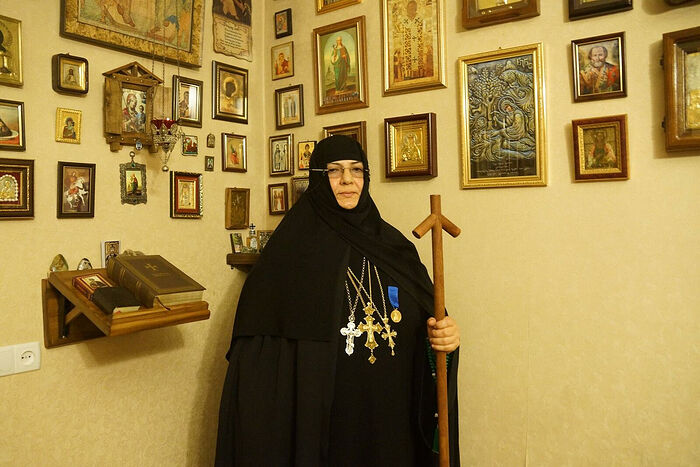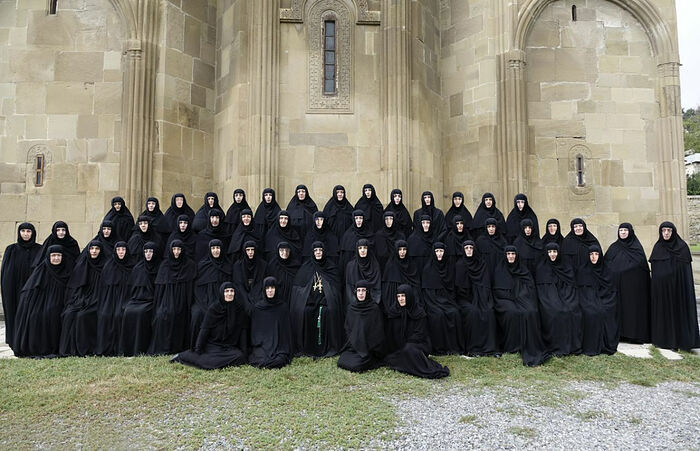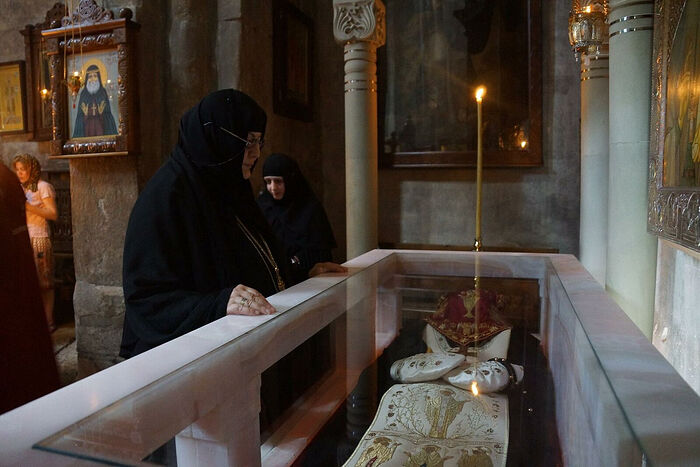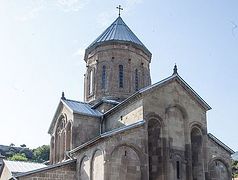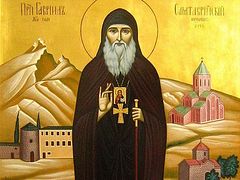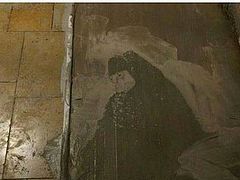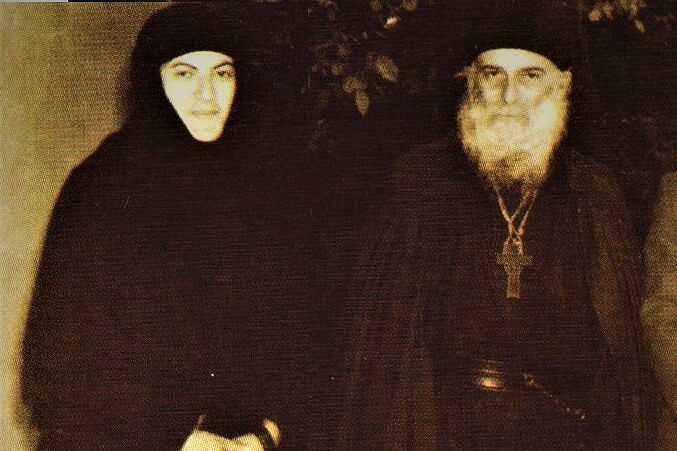 Abbess Ketevan (Kopaliani) with Elder Gabriel
Abbess Ketevan (Kopaliani) with Elder Gabriel
The birthday of the venerable Elder Gabriel (Urgebadze), August 26, was recently commemorated. This day is especially celebrated in the Samtavro Convent, where St. Gabriel served as spiritual guide in the last years of his life.
When the current abbess of Samtavro Monastery, Ketevan (Kopaliani), was still in the world, the elder once told her: “May the Lord bless you, my child. You will be the mother of Georgia!” She was embarrassed, considering it a frivolous exaggeration, even a joke, because the Mother of Georgia is considered to be St. Nina; but on July 13, 1991, when she became the abbess of Samtavro Monastery, everyone understood what Elder Gabriel was talking about: Samtavro is the monastery of the holy Equal-to-the-Apostles Nina and is considered the mother of all monasteries, and the abbess of this monastery—the mother of all Georgia.
Abbess Ketevan (Kopaliani) recalls the prophecies, personality, and love of Elder Gabriel.
***
The Christian Church resembles a ship, where the helmsman is Christ Himself and the mast is the Life-giving Cross. Who knows how many times the waves of heretics have struck this ship. More than once these waves have threatened to sink the Orthodox Church, but protected by its Heavenly Helmsman—our Lord Jesus Christ, it remains invincible. Blessed is he who does not leave this ship. Only there can you reach the dock of the Kingdom of Heaven, as it says in the ancient Patericon.
One of those who sought this treasured pier with deep faith was our father and confessor Archimandrite Gabriel. Obviously, many people remember the foolish elder in a kamilavka, wandering around the streets of Tbilisi, sometimes barefoot, with a diadem on his head.
I first saw Fr. Gabriel on Rustaveli Avenue in the 1980s. Raising his hands to Heaven, he called out: “Georgians! Wake up and see what is happening in Georgia, what state the grave of St. Shushanik is in! Is the Metekhi Church really a place for a theater?!”
The Elder wept aloud, suffering for the faith of the people and the Church. Some would pause, listening sympathetically, while others smiled skeptically. After this, I visited the Metekhi Church and the reliquary of St. Shushanik. Indeed, the grave of the saint was strewn with theater props.
Once I went up to him for a blessing. “May the Lord bless you, my child. You will be the mother of Georgia!” the elder exclaimed. I was embarrassed, considering it a frivolous exaggeration, even a joke, because the Mother of Georgia is considered to be St. Nina. A while later, with God’s help, I was tonsured by His Holiness. And a few years later, the Patriarch had to appoint an abbess to Samtavro Convent. I shared my fears with Fr. Gabriel, concerned that this heavy cross would be laid upon me. The elder began to console me: “Don’t worry, sister and mother. The grace of God is descending upon you. Don’t resist it: If the Patriarch blesses, it means it’s the will of God. The rank of abbess not only exalts, but also abases. To some it is given for salvation, and to others for destruction. If an abbess abases herself, she is on the path to salvation.”
One day we left Samtavro to go see Schema-Archimandrite Vitaly (Sidorenko) and Schema-Abbess Seraphima (Dyachenko) to get some mantias. They met us with love. As we walked in, Fr. Vitaly gave me a big prostration and sat down on the ground. I thought Fr. Vitaly must be a fool-for-Christ. When Mother Seraphima brought the mantias out, Fr. Vitaly jumped up, grabbed one of the mantias from Mother Seraphima, dressed me in it himself and gave me a Theotokos-Abbess icon. A copy of this icon was made by Nun Nana (Kutateladze), and this icon is in my cell to this day. Fr. Vitaly donated an icon of St. Stephen the Proto-Martyr to the monastery. And Metropolitan Daniel—then the abbot of the monastery—gave us the will of the elder: Every evening, after Vespers, go around the church with it in procession. This blessing is still being fulfilled to this day.
Fr Gabriel and Fr. Vitaly were connected by spiritual closeness and the similarity of their podvigs. As a sign of mutual understanding and mutual respect, they exchanged pectoral crosses. Schema-Archimandrite Vitaly was laid to rest in Tbilisi, at the Church of the Holy and Right-Believing Prince Alexander Nevsky, and Schema-Abbess Seraphima found her final resting place in our Samtavro Monastery.
On July 13, 1991, on the feast of the Twelve Apostles, His Holiness and Beatitude Ilia II blessed me to become the abbess of Samtavro Monastery, elevated me to the rank of igumena, and handed me the staff and a richly-decorated cross. Thus the elder’s prophecy was fulfilled: After all, Samtavro—the Monastery of the Holy Equal-to-the-Apostles Nina—is considered the mother of all monasteries, and it’s abbess—the mother of all Georgia.
Fr. Gabriel was distinguished by a special grace. He saw the image of God in everyone, not discriminating against anyone. He always sympathized with the weak and was amazingly meek, considering himself the greatest of sinners and would call us to humility. He often instructed us: “All sins are as stones before God. There is not a sin in the world that could surpass the mercy of the Lord.”
Once, when I was riassophore nun, Fr. Gabriel closed the doors of the trapeza, detaining the nuns there, and he told me to bring a basin and wash everyone’s hands. Having fulfilled his blessing, I went up to him, holding the basin with dirty water in my hands. The elder looked at me searchingly and invited me to drink this water. I asked confusedly: “All of it?” “Yes, to the bottom!” he answered in Russian. There was no time to think, so I had to drink it. He embraced me, blessed me, and said: “You’ll come in handy as an abbess…”
There wasn’t a moment when Fr. Gabriel wasn’t thinking about God. He always taught us to pray with fear and reverence. Sometimes he would mimic it: “Tra-ta-ta-ta-, ra-ta-ta-ta… Are you praying, swearing, or reading the newspaper?! Like a Chapaev machine gun! Think: TO WHOM are you praying, WITH WHOM are you speaking. The Lord is ever invisibly with us.”
One time, Abbess Georgia from the Jerusalem Monastery of St. John the Baptist visited the Convent of St. Nina. I knew her from Pukhtitsa Monastery. Mother Georgia wanted to meet Fr. Gabriel. She spoke with the elder for a long time. Coming out of his cell in tears, she joyfully said: “You have a true elder—you’re in Paradise.”
Batiushka did not accept human praise. In such instances, he would start acting foolishly,[1] silencing those praising him. And if someone humbly came to him for advice, he would instruct them with Biblical wisdom. If someone needed strengthening in faith, Fr. Gabriel would tell them about miracles that happened to him.
One day we were visiting the church that Batiushka built himself. He told us:
“The roof was leaking, and I was grieving: What would become of the icons? I needed several cubic meters of building material for repairs, but I had no money. I was really worried and prayed to God for help. I was suddenly visited by a stranger who turned out to be an engineer. He looked at the icons and then said in surprise: ‘It’s strange, I was in a big hurry, but some force made me come here. You know what this icon is asking me now? To donate a few cubic meters of wood to the elder.”
The elder showed him an icon of the Savior before which he himself prayed to God for help. Overjoyed, the layman promised to donate everything needed, and he kept his word.
The elder would call Jehovah’s Witnesses and other heretics visible demons, messengers of satan, and strictly forbade entering into a dispute with them, because the Gospel says: Give not that which is holy unto the dogs, neither cast ye your pearls before swine, lest they trample them under their feet, and turn again and rend (Mt. 7:6).
St. Gabriel was truly a wise old pauper. He would joyfully give others even the things he himself needed most. One time, after Liturgy, I met Fr. Gabriel on the steps. He looked at me and my new mantia with his warm look. “I don’t even have a mantia like that,” the Elder said. I immediately took it off and handed it to the elder. I later found out that he gave this mantia to the now-reposed Schemanun Nino (Dashniani). A little while later, Elder Gabriel asked me to give him a second mantia. Of course, I gave it, and Nun Paraskeva hung it in a corner of the tower. I didn’t pay any special attention to it then. Today I thank the Lord that Elder Gabriel was buried in this mantia.
The elder was often visited by his mother, Barbara, at that time. After Fr. Gabriel’s repose , she remained in the monastery for good. After a while it was decided to tonsure her as a nun with the name Anna. The robes were prepared by the mothers of the monastery. The rite was served by Fr. Savva Kuchava. During the tonsure, I covered her with my mantia, led her to the amvon, and repeated the words for her, because she was too old to do it herself. Thus, I had to take my vows a second time.
On May 22, 2000, the feast of St. Shio of Mgvime, the nuns of the Monastery of the Holy Equal-to-the-Apostles Nina went to St. Shio Monastery to venerate his relics. Metropolitan Daniel served the Liturgy. Patriarch Ilia II served a moleben at the saint’s grave. While they were setting the table, I went up to the trapeza, where the iconostasis and frescoes of the church are clearly visible from the balcony. I was praying the Jesus Prayer on my prayer rope and I couldn’t help thinking about Fr. Gabriel. Suddenly there was a fresco glowing high in the sky in front of me, and above it was an inscription in ancient Georgian that I could barely make out: “St. Gabriel of Georgia.” In his hands was an icon of the Mother of God. Nearby were Fr. Gabriel’s favorite icons—of the Great Martyrs Shushanik and Ketevan.
A wonderful feeling took hold of me! How many times I had visited St. Shio Monastery, and I never noticed these icons. It was impossible to hide my joy. I told Bishop Michael about what I had seen. He agreed that it was the elder showing me a miracle.
Fr. Gabriel, who appeared to me as Gabriel of Georgia, gave me to feel his protection. This vision further strengthened my faith in the immortality of the soul. I found a comforter and intercessor for us in the person of our own fool-for-Christ elder.
P.S. Abbess Ketevan (Kopaliani) has written a new song about St. Gabriel:

